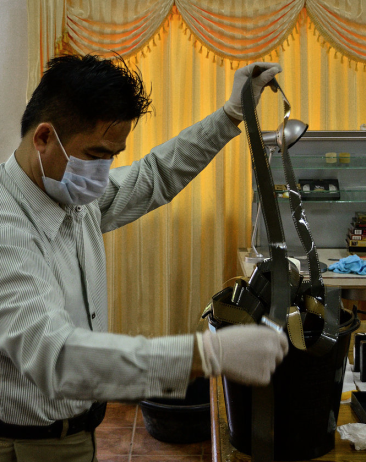Founded in 1996, The South East Asia Pacific Audio Visual Archives Association (SEAPAVAA) aims to provide a regional voice for audiovisual collections and enable a forum to address some common issues and concerns related to the collection, preservation and access to audiovisual materials.
Below is an excerpt from a 2103 Australian Institute for the Conservation of Cultural Materials (AICCM) National Conference paper - 'Filling the niche: Supporting the preservation of audiovisual collections in SE Asia and the Pacific region" by Shingo Ishikawa and Mick Newman from the National Film and Sound Archive of Australia (NFSA) describing their involvement in SEAPAVAA.
"Internationally, audiovisual archives are a small community and there is a strong ethic of sharing of information. For the first few years of its existence the NFSA was comparatively isolated by distance and time zones. Forming personal networks was difficult but crucial to enabling sharing. For audiovisual archives in many SE Asian countries the problems were exacerbated with language also increasing the isolation.
SEAPAVAA was formed in 1996. NFSA was a founding member and has been active in supporting SEAPAVAA in a variety of ways, including elected roles on the Executive Council, training workshops in conjunction with SEAPAVAA conferences and specific training projects. NFSA has long had a culture of research and has added significantly to the body of knowledge of audiovisual archiving. Over the years NFSA has partnered with industry experts, universities and manufacturers to understand and develop solutions to the problems that beset audiovisual collections.
Developing a relationship that not only crosses borders but also cultures is a long term process. While there was common ground in the goals of the respective organisations in SEAPAVAA in the region, the approach needed to be mutualistic. It was clear from the outset that the approaches used by the basically European and US based audiovisual archives were not necessarily applicable to the region. The low level of resource available even to national organisations was inadequate to keep pace with the “best practice” as advocated by the peak bodies.
This is best illustrated in ISO Standards. These standards define the parameters required for optimum processes and procedures. Clearly meeting the technical standards for tasks such as film storage in a tropical region requires far more in the way of building performance and infrastructure than it does in a more temperate climate. This increased need for high specifications combined with a lower level of resource means that very few archives in the region could hope to meet any part of the standard. Many managers felt that if they couldn’t meet the standard then it was a waste of time doing anything. Consequently the standards became an impediment for audiovisual archiving rather than a building block.
Working to create the attitude of using standards as aspirational rather than mandatory helped in developing mutual understanding of problems and achievable solutions. Here NFSA was able to apply its research capability by taking the conditions and resources found in SE Asia and the Pacific, extracting crucial elements from the standards and analysing the gap. The resulting analysis could be further dissected into areas where a pragmatic or compromise approach was feasible and those that really required a best practice approach. While undertaking this type of analysis the experience gained in analysis also benefitted NFSA by expanding our knowledge and capacity to deal with the issues we also faced with archiving at-risk audiovisual objects. "
More information about SEAPAVAA can be found at http://www.seapavaa.com
Reference: Ishikawa, S & Newnham, M, 2013, Filling the niche: Supporting the preservation of audiovisual collections in SE Asia and the Pacific region in Contexts for Conservation, AICCM 2013 National Conference, Adelaide 23- 25 October, Australian Institute for the Conservation of Cultural Materials.
First posted incca-ap.org 2014

